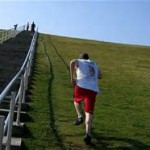SPRINT!
Add sprint intervals into your walking, jogging or running workout.
Find a 50-100 yard path that allows you to perform regular timed sprint repeats. After a sufficient warm up of 8-10 minutes, sprint your time trial for a base interval. Repeat the intervals as long as you can log a decreased time each one. All-out intervals challenge your cardiovascular system, and your muscles, all in one time-efficient workout. Perform your sprint workout once each week to allow recovery of your muscles. This workout is for intermediate/advanced exercise without injury concerns.
*Consult your physician before performing exercise.
 Subscribe
Subscribe




